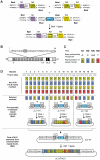Assembly of designer TAL effectors by Golden Gate cloning
- PMID: 21625552
- PMCID: PMC3098256
- DOI: 10.1371/journal.pone.0019722
Assembly of designer TAL effectors by Golden Gate cloning
Abstract
Generation of customized DNA binding domains targeting unique sequences in complex genomes is crucial for many biotechnological applications. The recently described DNA binding domain of the transcription activator-like effectors (TALEs) from Xanthomonas consists of a series of repeats arranged in tandem, each repeat binding a nucleotide of the target sequence. We present here a strategy for engineering of TALE proteins with novel DNA binding specificities based on the 17.5 repeat-containing AvrBs3 TALE as a scaffold. For each of the 17 full repeats, four module types were generated, each with a distinct base preference. Using this set of 68 repeat modules, recognition domains for any 17 nucleotide DNA target sequence of choice can be constructed by assembling selected modules in a defined linear order. Assembly is performed in two successive one-pot cloning steps using the Golden Gate cloning method that allows seamless fusion of multiple DNA fragments. Applying this strategy, we assembled designer TALEs with new target specificities and tested their function in vivo.
Conflict of interest statement
Figures


References
-
- Urnov FD, Rebar EJ, Holmes MC, Zhang HS, Gregory PD. Genome editing with engineered zinc finger nucleases. Nat Rev Genet. 2010;11:636–646. - PubMed
-
- Kay S, Hahn S, Marois E, Hause G, Bonas U. A bacterial effector acts as a plant transcription factor and induces a cell size regulator. Science. 2007;318:648–651. - PubMed
-
- Romer P, Hahn S, Jordan T, Strauss T, Bonas U, et al. Plant pathogen recognition mediated by promoter activation of the pepper Bs3 resistance gene. Science. 2007;318:645–648. - PubMed
-
- Boch J, Bonas U. Xanthomonas AvrBs3 family-type III effectors: discovery and function. Annu Rev Phytopathol. 2010;48:419–436. - PubMed
-
- Bogdanove AJ, Schornack S, Lahaye T. TAL effectors: finding plant genes for disease and defense. Curr Opin Plant Biol. 2010;13:394–401. - PubMed
Publication types
MeSH terms
Substances
LinkOut - more resources
Full Text Sources
Other Literature Sources
Miscellaneous

